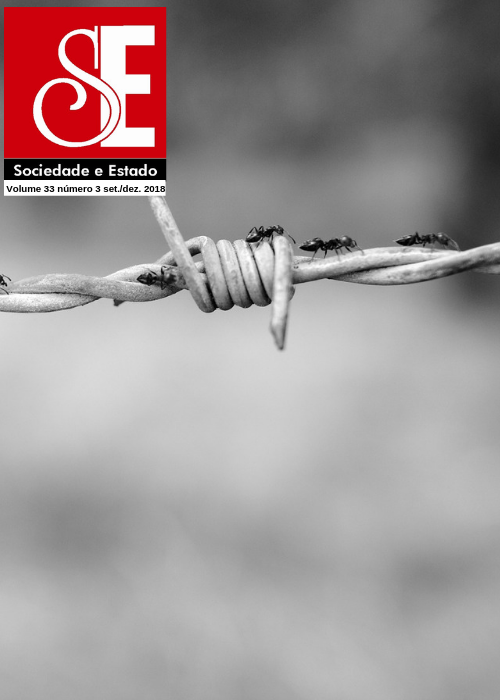Desistance from crime
DOI:
https://doi.org/10.1590/s0102-6992-201833030008Keywords:
Desistance from crime, Maturational reform, Turning points, Tertiary prevention, Former inmate supportAbstract
The text explores the concept of desistance from crime, which has been increasingly used in contemporary criminological literature, debating the subject of stability and behavioural change from new theoretical principles. The work discusses the contributions of different criminological theories and offers an overview on the main evidence found in longitudinal studies, highlighting the relevance of the age factor for the desistance considered by the “maturational reform” hypothesis. The “life-course perspective” (Sampson & Laub, 1995) indicates the so-called “turning points”, represented by special events correlated to desistance, such as marriage, birth of the first child, first formal job experience, amongst others. The international experience sustains that the phenomenon of desistance can be broadly stimulated through public policy and specific programs, which would most likely achieve positive results as to the overall safety of the population. In its final part, this challenge is applied to the Brazilian context, and paths to tertiary prevention, specifically regarding the community integration of former inmates, are suggested.
Downloads
References
ARIELY, Dan. Positivamente irracional: os benefícios inesperados de desafiar a lógica em todos os aspectos de nossas vidas. Rio de Janeiro: Campus Elsevier, 2010. [ Links ]
BEIRNE, Piers. Adolphe Quetelet and the origins of positivist criminology. American Journal of Sociology, v. 92, n. 5, p. 1140-1169, 1987. [ Links ]
BLUMENSTEIN, Alfred; COHEN, Jacqueline; FARRINGTON, David P. Criminal career research: its value for criminology. Criminology, v. 26, p. 1-35, 1988. [ Links ]
BOONE, Miranda. Judicial rehabilitation in the Netherlands: balancing between safety and privacy. European Journal of Probation, v. 3, n. 1, p. 63-78, University of Bucharest, 2011. [ Links ]
BRAFMAN, Ori; BRAFMAN, Rom. A força do absurdo. Rio de Janeiro: Objetiva, 2009. [ Links ]
CARLSSON, Christoffer. Using "turning points" to understand processes of change in offending. Notes from a swedish study on life courses and crime. British Journal of Criminology, v. 52, p. 1-16, 2012. [ Links ]
CORDEIRO, Laurentino André; COELHO, Kellen da Silva; KANITZ, Amarildo F.; SILVA GONÇALVES, Helen. Os reflexos da capacitação fora das grades: a ressocialização dos ex-detentos do complexo penitenciário de São Pedro de Alcântara (SC/Brasil) Reice. Revista Iberoamericana sobre Calidad, Eficacia y Cambio en Educación, v. 12, n. 2, p. 139-162, 2014. [ Links ]
FARRALL, S.; CALVERLEY, A. Understanding desistance from crime: Theoretical directions in resettlement and rehabilitation. Maidenhead (UK): Open University Press, 2006. [ Links ]
FARRAL, S.; BOTTOMS, A.; SHAPLAND, J. Social structures and desistance from crime. European Journal of Criminology, v. 7, p. 546-569, 2010. [ Links ]
FARRINGTON, D. P. Explaining the beginning, progress, and ending of antisocial behaviour from Birth to adulthood. In: MCCORD, J. (Ed.). Facts, frameworks, and forecasts: advances in criminological theory. v. 3. New Brunswick (NJ): Transaction Publishers, 1992. [ Links ]
____ . Self-reported and official offending from adolescence to adulthood, In: KLEIN, M. W. (Ed.). Cross-national research in self-reported crime and delinquency. Dordrecht (NL): Kluwer, 1989. [ Links ]
____ . Age and crime. In: TONRY, Michael; MORRIS, Norval (Eds). Crime and justice. v. 7, p. 189-250. Chicago (IL): University Press, 1986. [ Links ]
FOX, Katheryn J. Theorizing community integration as desistance-promotion. Criminal Justice and Behavior, v. 42, n. 1, p. 82-94, 2015. [ Links ]
GOTTFREDSON, Michael; HIRSCHI, Travis. A general theory of crime. Stanford (CA): Stanford University Press, 1990. [ Links ]
GRAHAM, J.; BOWLING, B. Young people and crime. London: Home Office, 1995. [ Links ]
HELYAR-CARDWELL, Vicki. Fathers for good? Exploring the impact of becoming a father on young offenders’ desistance from crime. Safer Communities, v. 11. n. 4, p. 169-178, 2012. [ Links ]
HIRSHI, Travis; GOTTFREDSON, Michael. Age and the explanation of crime. American Journal of Sociology, v. 89, p. 552-584, 1983. [ Links ]
HOLLIS, James, A sombra interior: porque pessoas boas fazem coisas ruins? São Paulo: Novo Século, 2010. [ Links ]
HUESMANN, L. R.; ERON, L. D.; LEFKOWITZ, M. M.; WALDER L. O. The stability of aggression over time and generations. Developmental Psychology, v. 20, p. 1120-1134, 1984. [ Links ]
JOHNSON, S. B. et alii. Adolescent maturity and the brain: the promise and pitfalls of neuroscience. Research in adolescent health policy. Journal of Adolescent Health, v. 45, n. 3, p. 216-221, 2009. [ Links ]
JULIÃO, Elionaldo Fernandes. O impacto da educação e do trabalho como programas de reinserção social na política de execução penal do Rio de Janeiro. Rev. Bras. Educ. v. 15, n. 45, 2010. [ Links ]
LOEBER, Rolf. The stability of antisocial child behavior: a review. Child Development, v. 53, p. 1431-1446, 1982. [ Links ]
MARUNA, Shadd. Making good: how ex-convicts reform and rebuild their lives. Washington (DC): APA Books, 2001. [ Links ]
MARUNA, Shadd; LEBEL, T. P.; LANIER, C. Understading desistance from crime. London: Rehabilitation Services Group; National Offender Managment Service; Ministry of Justice (UK), 2010. [ Links ]
____ . Generativity behind bars: some “redemptive truth” about prison society. In: ST. AUBIN, E. de; MCADAMS, D.; KIM T. (Eds.). The generative society: caring for future generations, p. 131-151. Washington (DC): American Psychological Association, 2003. [ Links ]
MATZA, D. Delinquency and drift. New York: John Wiley and Sons, 1964. [ Links ]
METTIFOGO, Decio; ARÉVOLO, Camila; GOMÉS, Francisca; MONTEDÓNICO, Sofia; SILVA, Luis. Factores transicionales y narrativas de cambio en jóvenes infractores de ley: análisis de las narrativas de jóvenes condenados por la Ley de Responsabilidad Penal Adolescente. Psicoperspectivas, v. 14, n. 1, Valparaíso (CL), 2015. [ Links ]
MLODINOW, Leonard. Subliminar: como o inconsciente influencia nossas vidas. Rio de Janeiro: Zahar, 2012. [ Links ]
MONSBAKKEN, Christian Weisæth; LYNGSTAD, Torkild Hovde; SKARDHAMAR, Torbjørn. Crime and the transition to parenthood: the role of sex and relationship context. British Journal of Criminology, v. 53, p. 129-148, 2012. [ Links ]
PIQUERO, A. R.; FARRINGTON, D. P.; BLUMSTEIN, A. Key issues in criminal career research. New analyses of the Cambridge Study in delinquent development. Cambridge (MA): Cambridge University Press, 2007. [ Links ]
ROLIM, Marcos. A formação de jovens violentos: estudo sobre a etiologia da violência extrema. Curitiba (PR): Appris, 2016. [ Links ]
SAMPSON, Robert J.; LAUB, John H. Crime in the making: pathways and turning points through life. Cambridge (MA): Harvard University Press, 1995. [ Links ]
SOWELL, Elizabeth et alii. In vivo evidence for post-adolescent brain maturation in frontal and striatal regions. Nature Neuroscience, v. 10, 1999. [ Links ]
STONE, Rebecca. Desistance and identity repair: redemption narrative as resistance to stigma. British Journal of Criminology, v. 56, n. 5, p. 956-975, 2015. [ Links ]
SYKES, G. M.; MATZA, D. Techniques of neutralization: a theory of delinquency. American Sociological Review, v. 22, n. 1, p. 664-670, 1957. [ Links ]
THORNBERRY, Terence P.; KROHN, Marvin D. The self-report method for measuring delinquency and crime. In: Measurement and analysis of crime and justice. Washington (DC): U.S. Department of Justice Office of Justice Programs Washington (DC), 2000. [ Links ]
UGGEN, Christopher. Work as a turning point in the life course of criminals: a duration model of age, employment, and recidivism. American Sociological Review, v. 65, n. 4, p. 529-546, 2000. [ Links ]
VAN MASTRIGT, S. B.; FARRINGTON, D. P. Co-offending, age, gender and crime type: implications for criminal justice policy. British Journal of Criminology, v. 49, p. 552-573, 2009.
VAUGHAN, Barry, The internal narrative of desistance. British Journal of Criminology, v. 47, p. 390-404, 2007.
WAUTERS, E. A reinserção social pelo trabalho. Curitiba: Universidade Federal do Paraná, 2003.




.jpg)



















